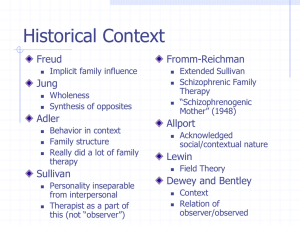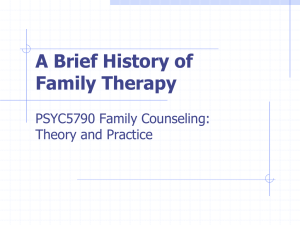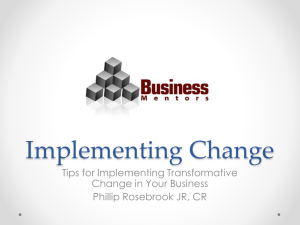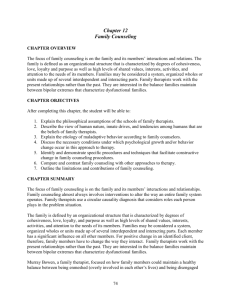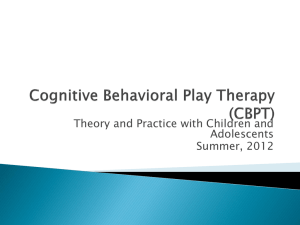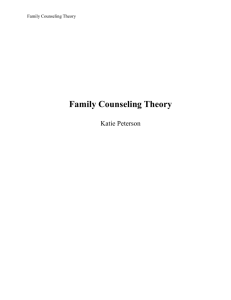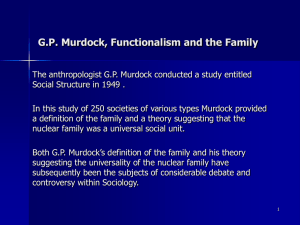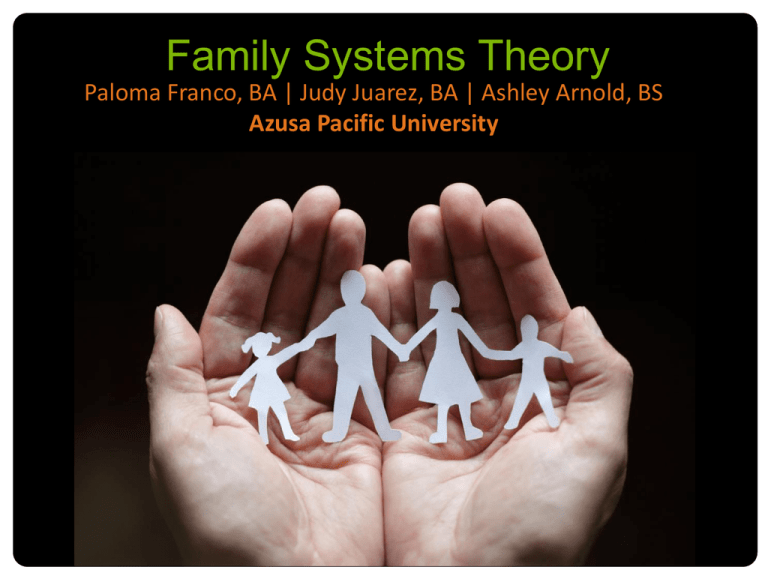
Family Systems Theory
Paloma Franco, BA | Judy Juarez, BA | Ashley Arnold, BS
Azusa Pacific University
What we will cover today:
What is a
family?
Cultural
Awareness
Background
of FST
Four Major
Approaches
•
•
•
•
Satir
Structural
Strategic
Bowens
Faith
Component
Application
to Student
Affairs
FAMILY:
Household:
Particular societal construct whereby
persons are related by ancestry,
marriage, adoption, or choice.
Residential unit in which members
share resources. These units vary in
membership and composition.
A household is not always a family (parents and
children), and a family is not always a household
(because it may be separated geographically).
(Zinn, Eitzen & Wells, 2008)
What is a family?
Cultural awareness
• Some of the criticisms of
FST is that it upholds a
model of white, middleclass families that is not
applicable to individuals
from other cultural or
ethnic origins (Murdock,
2004).
• FST often assumes:
• patriarchal and cultural
biases
Cultural awareness
• Ethnicity
• Language
• Customs and
Traditions
• Generations
• Religion
• LGBT
• Economic status
ACTIVITY:
Fst background
There is still some question on whether doing Family
System therapy without the complete family group
represent is effective. (Murdock, 2004)
• This theory is considered one of
the major schools of counseling
and psychotherapy
• It can be used with individual
clients
• Theorists believe that they can
best understand the individual
through understanding his/her
experiences as a member of the
family
Fst background
Family system theorist are considering the best
way to approach helping individuals is to see
them in context, as a part of a larger system,
and they tend to focus on the relationships
among individuals who are members of the
system (Beckvar & Beckvar, 2003)
GOALS OF FAMILY SYSTEMS
THEORY:
• To enhance the self esteem of family members (Woods &
Martin, 1984)
• To release the blocked potential of families and engaging
the healing powers of the client (Satir, 2000)
• To bring awareness and change in the social system (e.g.,
the family) as in the individual. (Murdock, 2004)
FST BACKGROUND
ACTIVITY: FAMILY AS A
SYSTEM
6 Volunteers
The family is interconnected, and influences on one part of
the system will affect other parts. (Murdock, 2004)
Four major approaches:
SATIR
STRUCTURAL
STRATEGIC
BOWENS FST
Satir approach
•
•
•
•
Virginia Satir
1916-1988
Satir was known worldwide
as a pioneer in the
development of family
therapy.
Satir saw her approach as
helping people gain a sense
of their wholeness and
potential and a commitment
to individual awareness and
expression, self-fulfillment,
and individual growth.
Underlying Philosophy or Assumptions:
• Past generations, has a significant influence on our attitudes
and behaviors.
• Each person contains all the resources one needs for growth
and healthy functioning.
• The result of dysfunctional family systems is low self-esteem
and defensive behavior, as the basic drive of human beings is
to enhance self-esteem and defend against threats to it.
(Marley & Rasheed.J, Rasheed. M, 2011)
Central constructs:
self esteem affirmation
• The degree to which the individual values
•
himself regardless of the opinions of others
(Satir & Baldwin, 1983).
People with low self worth are anxious and
uncertain about themselves and overly
concerned with other's evaluations of them.
Central constructs:
self mandala
• Philosophy was that our self
was composed of many
different parts and that each
of these parts had to be
nurtured each and every day
in order for us to be content
and fulfilled. Satir's parts of
the self are described below:
(Marley & Rasheed.J,
Rasheed. M, 2011)
Central constructs:
communication
•
•
Functional Families:
Communication is; clear, complete,
congruent communication in which
there are clear roles and rules to
govern family processes.
Open system: a clear interchange of
information and resources within and
without the system that is adaptive
and dynamic
•
•
Dysfunctional Families:
Communication is; indirect,
unclear, vague, dishonest,
distorted, and incomplete
Poor communication results in
low self esteem, which can
trigger an individual to
inappropriate response,
especially in times of high stress
•
•
•
•
•
Central constructs:
Family rules
The rules by which a family operates can be overt or covert.
If one is not happy, one is bad and disobedient; this
assessment can lead to low self-worth.
Flexibility and age appropriateness are also important to
family rules.
Rules should also allow for diversity among members' ways
of operating in the world, and also should allow for
members to share information freely.
Family secrets are a no-no in the Satir approach. (Murdock,
2004)
Process of therapy:
•
•
•
Stage One: Contact
o A counselor's job is to attempt to create an atmosphere of hope and
trust
o The counselor must make it obvious for family members what they
have observed and to make clear what family members often know
completely
Stage Two: Chaos (Complete disorder and confusion.)
o When one family member ventures into risky territory.
o Therapist helps the individual to reveal hurt, pain, and. or anger
that has previously remained hidden
o Therapist helps the individual stay in the present
Stage Three: Integration
o The family finds a way to move on the issue that created the chaos,
o Develops new ways of being, and some closure is gained on the
pivotal issue.
Structural therapy
Structural therapy: history
Salvador Minuchin
• 1921, Born and raised in Argentina
History
Beginnings:
o Worked at the Wiltwyck Center where
he:
Began to think about Family
therapy in his work with low
income African American families.
o Wrote book Family of the Slums
o Left Wiltwyck and began working at the
Philadelphia Child Guidance Clinic
o Worked with difficult clients
o Families of anorexic girls
o Learned the most about family
structure through observing
psychosomatic families
o Structural therapy was
prominent in the 1970’s
Quick facts about Structural Therapy
•
Structural therapy intent is to change the structure of the family system, which
then will impact the experiences of its members.
• Structural therapy is active and focused on the present. "The tool of this
therapy is to modify the present, not to explore and interpret the past"
(Minuchin, 1974).
• The personality of Minuchin is confused with the qualities and roles of the
structural therapist, because Minuchin includes his feelings about families and
life experiences as part of the therapeutic process.
Therapy Goals
To restructure family organization
To change dysfunctional transitional patterns
•
•
(Corey, 2009)
Central constructs
Family Structures
• "Family structure is a set of rules
that tells who talks with whom,
who plays with who, (and in what
ways), and so forth” (Murdock,
2004)
Subsystems
• Smaller group within the family,
such as
• also known as coalitions
Boundaries
• Important because they protect the
morals of the subsystem
• Disengaged: boundaries are too rigid
• Enmeshed: boundaries are unclear
Theory of person and development of the
individual
Four main stages of family development:
Couple Formation
Families with young children
Families with school-age or adolescent children
Families with grown children
Theory of person and development of the
individual
The Individual
• The identity of the individual is composed of a balance between
individuality and belonging
• In a healthy family, the individual can maintain good balance between
individualization and belonging to the family.
• In an unhealthy family, the individual struggles or does not have good
balance between individualization and belonging to the family.
• Individuals in disengaged families: allows a lot of individuality
• Individuals in enmeshed families: expects less individuality and more of
loyalty and conformity
Patterns
• Detouring or scapegoating
When a parental dyad is openly split..
• Parent- Child Coalition
• Triangulation
(Murdock, 2004)
Nature of therapy
•Assessment
•Atmosphere
Process of Therapy
Joining: The structural therapist leads the
system but they also must become a
member of it
Therapeutic Techniques
3 Strategies:
Challenges are made to the
a) view of the symptom
b) family structure
c) family reality
(Murdock, 2004)
Nature of therapy
a) View of the symptom
Techniques
Reframing
To change how the family views the
symptom:
• Enactment
• Focusing
• Achieving intensity
b) Family Structure
Techniques
• Boundary Making: use to create
better boundaries within the family
structure
• Unbalancing: intentional to
changing the hierarchy of the family
• Teaching complementarity: allows
the member to become aware of
their behaviors and how that impact
the family as a whole which then
changes the way the family looks at
the problem
(Murdock, 2004)
Nature of therapy
c) Family reality
Techniques (Paradoxical)
Emphasizing on the strengths that the family already possesses.
Role and function of the therapist: "Friendly uncle" or promoter of change
(Corey, 2009)
Strategic therapy
Strategic therapy
Jay Haley
1923-2007
• Combined structural family therapy
with ideas of hierarchy, power, and
strategic interventions.
• Master's in Arts and Communication
• Influenced by communication
dynamics and the work of Milton
Erickson
Cloe Madanes
1941-
• Another leading advocate of strategic
therapy was Cloe Madanes, who was
also at married to Haley.
• Founded the Family Institute in
Washington,D.C.in 1970's
• This therapy became the most popular
family therapy approach by the 1980's.
(Corey, 2009)
Strategic therapy
History(continued)
•
Developed from the work of early
systems theorist from Bateson and
What is Strategic Therapy?
colleagues at the Mental Research
Therapist initiates goals and
Institute in Palo Alto, Ca
creates an approach for each
Haley (1974) views family problem as
problems.
"real" problems that need real
Symptoms are seen as ways to
answers.
communicate.
Haley spent 10 years working
Therapist evaluate the family
Minuchin.
through observing their
interactions
•
•
•
Goal
• To solve the presenting problem
•
•
Strategic therapy: central constructs
Communication
•Digital
• Analog (or Metaphoric)
On hierarchies, just because an unfair hierarchy does not
indicate as a justification that one should change it as a
therapist.
(Murdock, 2004)
Strategic therapy: theory of person and development of
the individual
Theory of Person
Strategic therapist do not have a theory of personality
Do not explore on healthy people and families
Important life stages in Strategic Therapy (According to Haley, 1973)
1. Courting period
2. Early Marriage
3. Childbirth and dealing with the young
4. Middle age
5. Weaning parents from children
6. Retirement and old age
The impact of hierarchy
Within the family structure..
• Having problematic hierarchies creates problems in families because there is
an unbalance
• Problematic hierarchies are linked rigid behavior within the family
Confused hierarchies can also occur in healthy family structures
Strategic therapy: nature of therapy
Nature of Therapy
• This therapy does not have a
formal assessment (or diagnosis)
because they believe that
"diagnostic labels" are risky.
• Psychoactive medication should
be discontinued
Process of Therapy
• Haley (1974) first counseling
session with family
• Mandatory for everyone to
be there
Five Stages:
1. Social
2. Problem
3. Interaction
4. Goal Setting
5. Getting to know members
(Murdock, 2004)
Strategic therapy:
therapeutic techniques
• Directives - is use with the primary goal of getting people to
change their behavior
• Straightforward directive
• Paradoxial directive
• Reframing - changing the way the problem is viewed
• Role and Function of the therapist: Active director of change
(Corey, 2009)
Bowens family systems therapy
(BFST)
history
• Dr. Murray Bowen
• Began his theoretical work with
Schizophrenia.
• Best known for two pioneering
advances in family therapy:
• He experimented with
hospitalizing the entire
families of schizophrenics,
practicing family group
therapy.
• Personal analysis of his own
journey to differentiate from
his family of origin.
Central constructs
Differentiation of self
The ability of a particular family member to remain in contact
with and connected to the family system while also
maintaining emotional autonomy.
LOW
• Reactive;
they respond
based on
emotions
HIGH
• Solid sense of self.
They are clear about
where they end and
others begin. Their
behavior are guided
by their own
principles and
cognition rather
than emotional
factors.
Central constructs
Chronic
Anxiety
Triangles
Emotional
Distance
Nature of therapy
• Assessment: Informal
questioning & formal
(Genogram)
• Coaching
• Goals: to help the
individual(s)
differentiate from the
family of origin.
Therapeutic techniques
• No real "technique" instead, Bowen emphasized
"understanding of the family system"
• Process questioning
3 Methods by which the client works toward
differentiation of self:
1. Establish person-to-person relationships with
members of the family
2. Learn to be a better observer of family
interactions, and better at controlling emotional
reactions
3. Detriangling
My big fat Greek wedding
Ordinary people
Usefulness for Helping within Student
Development Work:
Usefulness for Helping within Student
Development Work:
1. The importance of environmental variables (e.g.,
family) in the creation and/or maintenance of
problems
• The focus would be more effective with
students if it acknowledged family dynamics
and dysfunctions rather than just the students
problems
Usefulness for Helping within Student
Development Work:
2. The importance of families in students' lives.
• Oftentimes, family closeness is regarded as a
source of support for students; however, it can
also be strong sense of stress for the student
and may need to be addressed when helping
students face the pressures of college.
Usefulness for Helping within Student
Development Work:
3. Extending the principles of system theory or family
therapy to groups (fraternities/sororities, RA staff
teams, organizations, etc.) may not only help the
individuals in psychological distress but also the
development and health of these larger social circles.
Usefulness for Helping within Student
Development Work:
Compatibility with Christian/Faith Based
Worldview:
•
•
•
•
Recent interest in exploring the FST and spirituality
Spirituality defined as "ways related to the sacred"
God as a member of a relational system
"Family Systems Theory, or Bowen Theory as it is
often called, is rapidly becoming one of the most
popular methodologies utilized by clergy (i.e.
ministers, priests, rabbis, imams, deacons, etc.) and
other faith leaders" (as cited in Center for FST of
New York webpage)
Questions?
References:
Beckvar, D.S., & Beckvar, R.J. (2003). Family therapy (5th ed.). Boston: Allyn and
Bacon.
Brennan, C., Eulberg, J. E., & Britton, P. J. (2011). Improving Awareness of
Vulnerabilities to Ethical Challenges: A Family Systems Approach. Journal Of
Systemic Therapies, 30(3), 73-85. doi:10.1521/jsyt.2011.30.3.73
Broderick, C. B. (1993). Understanding family process, basics of family systems theory.
Oaks, CA: Sage Publications, Inc.
Corey, G. (2009). Theory and practice of counseling and psychotherapy (8th ed).
Belmont: Thomson Brooks/ Cole.
Satir, V. (2000). The therapist story. In M. Baldwin (Ed.), The use of self in therapy (2nd
ed., pp.17-27). New York: Haworth.
Maiden Rootes, K. M., Jankowski, P. J., Sandage, S. T. (2010). Bowen family systems
and spirituality: Exploring the relationship triangulation and religious questing.
Contemporary Family Therapy, 32, (2), 89-101
Murdock, N. L. (2004). Theories of counseling and psychotherapy: A case approach.
Columbus, Ohio: Pearson Prentice Hall.
Reynolds, A.L. (2009). Helping college students: Developing essential support skills for
student affairs practice. San Francisco: Jossey-Bass.
Okun, B.F. (2002). Effective helping: Interviewing and counseling techniques (5th ed.).
Thousand Oaks, CA: Brooks/Cole.
Woods, M.D., & Martin, D. (1984). The Work of Virginia Satir: Understanding her
theory and technique. The American Journal of Family Therapy, 12(4), 3-11.
Zinn, M. B., Eitzen, D. S., & Wells, B. (2008). Diversity in families. (8 ed.). Allyn

